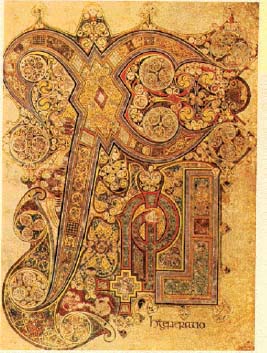The Medieval World, C. 400–1300Early Medieval Art from Northern Europe |
What is the Book of Kells? |
The Book of Kells is one of the most famous illuminated manuscripts, and is an example of medieval art that blends pagan design with Christian themes. The “Chi Rho Iota (XPI) Page” of the Hiberno-Saxon Book of Kells is astonishingly complex, filled with twisting lines and curling spirals similar to the intricate metalwork found with the Sutton Hoo ship, yet this page proclaims, “now this is how the birth of Christ came about” as it introduces the Gospel of Matthew. In Greek, the letters “chi,” “rho” and “iota” (XPI) are the initials of Christ. Looking closely at the swooping forms of the Greek letters, one can find human forms incorporated into the abstract design. The letter “P” curls into a spiral and is punctuated with a sideways, red-haired head, which also dots the “I” of the nearby “iota.” This head is thought to represent Christ. Playful animals are also hidden within the design, including cats, mice, otters, and fish, all of which were likely symbolic, although the meaning has been lost over time. The beauty and richness of the Book of Kells demonstrates both the artistic skill and religious passion of the ninth-century monks who produced it at the monastery on Iona, Scotland.

The illuminations in the spectacular gospel book the Books of Kells exemplify the way Christian art traditions blended with the pagan traditions of the British Isles in the early medieval period.
